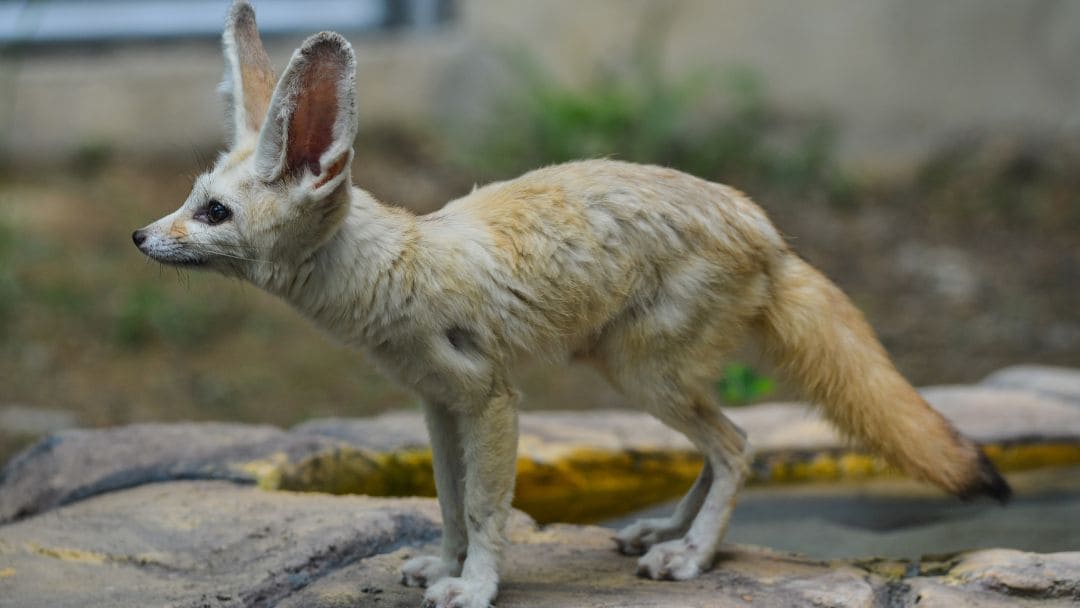Don’t let their size fool you! Fennec foxes are masters of survival in the harsh North African desert. Their oversized ears, sandy fur, and clever adaptations make them perfectly suited for the scorching heat and scarce water.
The Fennec fox (Vulpes zerda) is a captivating creature that reigns supreme in the vast, arid landscapes of North Africa. These tiny foxes, with their enormous ears, have become an iconic symbol of the desert. But how do they manage to thrive in such an unforgiving environment?
Let’s delve into the secrets behind their desert prowess, explore their fascinating communication methods, and discover their unique relationships with other desert dwellers.
Desert Dwellers: How Fennec Foxes Thrive in the Heat
Fennec foxes are living proof that incredible adaptations can lead to astonishing survival skills. Their most striking feature – those oversized ears – isn’t just for show!
These large ears act as natural radiators, helping them dissipate excess body heat and stay cool during the scorching desert days.
Here’s a closer look at their desert survival toolkit:
- Cooling Ears: The Fennec fox’s most recognizable feature is also its most important adaptation for the desert. Their large ears have a rich network of blood vessels close to the surface. By increasing blood flow to these ears, they can release heat back into the environment, keeping their body temperature regulated.
- Sandy Camouflage: Their fur’s sandy color blends perfectly with the desert landscape, making them nearly invisible to predators. This sandy coat also helps reflect sunlight, preventing them from overheating.
- Water Wizards: Fennec foxes have specialized kidneys that allow them to conserve water very efficiently. They can even obtain moisture from their food, further reducing their dependence on finding scarce water sources.
- Night owls: These clever foxes are primarily nocturnal. They avoid the hottest part of the day by staying cool underground in their dens during the daytime.
These adaptations, combined with their nocturnal lifestyle, make Fennec foxes perfectly suited for the harsh desert environment.
Chattering and Calling: The Vocal World of the Fennec Fox
Fennec foxes may be small, but their communication skills are big! They are highly vocal creatures who use a variety of sounds to interact with each other.
- A Symphony of Sounds: Their vocal repertoire includes barks, purrs, and even high-pitched screams. These sounds play a crucial role in their social lives.
- Marking Territory: They use barks to mark their territory and warn off intruders.
- Finding Love: High-pitched screams are used to attract mates during breeding season.
- Danger Alert: A chorus of barks can signal danger to other foxes in the area.
Listening to their eerie nighttime calls echoing across the dunes is a truly unforgettable experience, offering a glimpse into the fascinating communication network of these desert dwellers.
Desert Neighbors: Sharing the Sands with Other Creatures
The desert is home to a diverse array of wildlife, and Fennec foxes share their habitat with a variety of creatures, from scorpions and snakes to other small mammals. These foxes are opportunistic hunters, preying on small mammals, insects, and birds. Interestingly, they’ve developed a unique relationship with the Egyptian spiny-tailed lizard, or dhab.
- Burrowing Buddies: Fennec foxes are social animals that live in underground dens. Interestingly, they sometimes share these dens with the Egyptian spiny-tailed lizard. This mutually beneficial partnership provides both species with benefits. The shared den offers protection from predators and helps regulate temperature for both the foxes and the lizards.
The Fennec fox’s incredible adaptations and interactions with the desert ecosystem showcase the remarkable resilience of nature’s design. In the next section, we’ll explore the fascinating world of other fox species, each with their own unique story and adaptations for survival in diverse environments.
5 Fennec Fox FAQs: Unveiling the Desert’s Little Wonder
What makes Fennec foxes suited for the desert?
Fennec foxes boast unique adaptations for desert life. Their most iconic feature – those oversized ears – are natural radiators, helping them dissipate heat and stay cool. Their sandy fur acts like camouflage and reflects sunlight, and their specialized kidneys conserve water. They are perfectly equipped for the desert’s harsh conditions.
How do Fennec foxes communicate?
Don’t let their cuteness fool you – Fennec foxes are quite vocal! They have a diverse “vocabulary” of barks, purrs, and even high-pitched screams. These sounds help them mark territory, attract mates, and warn each other of danger. Hearing their eerie calls echoing across the dunes at night is an unforgettable experience.
What do Fennec foxes eat?
Fennec foxes are opportunistic hunters, preying on small mammals, insects, and birds. They also obtain moisture from their diet, further reducing their dependence on finding scarce water.
Do Fennec foxes live alone?
Fennec foxes are social creatures who live in underground dens. Interestingly, they sometimes share these dens with another desert dweller – the Egyptian spiny-tailed lizard. This unique partnership provides both species with benefits like safety and temperature regulation.
Are Fennec foxes endangered?
Thankfully, Fennec foxes are currently listed as “Least Concern” by the IUCN. However, habitat loss and the illegal pet trade can pose threats.


